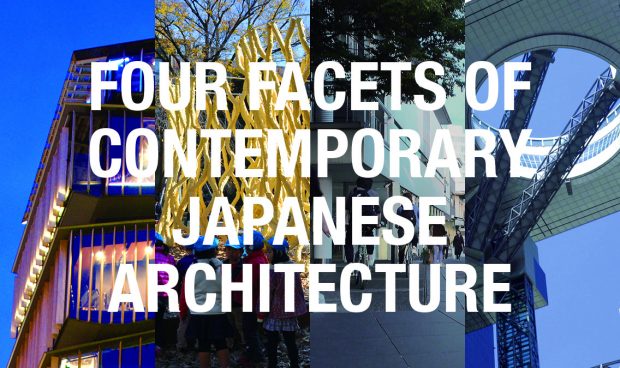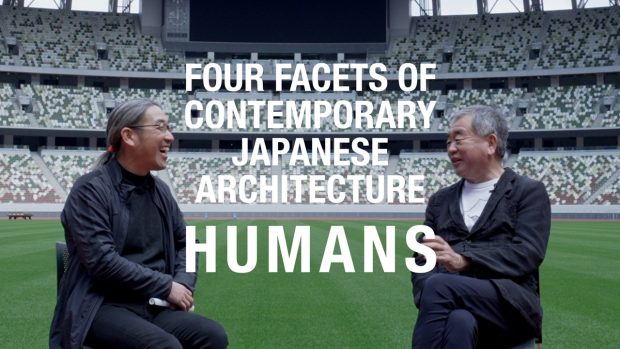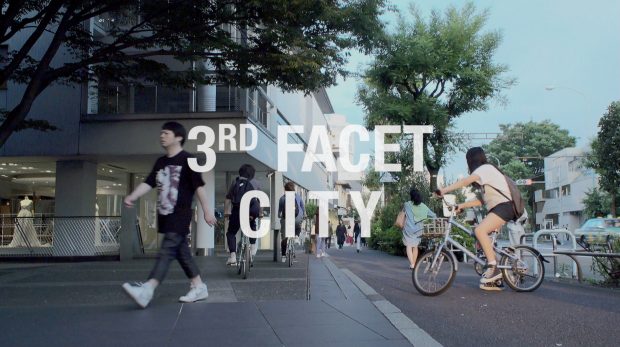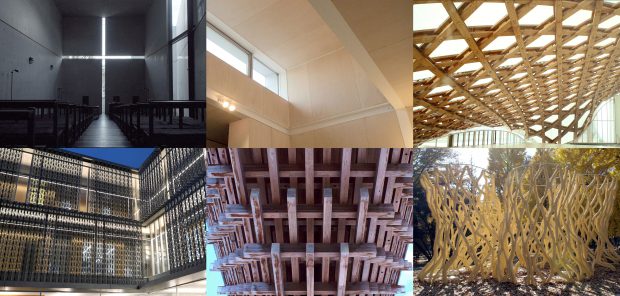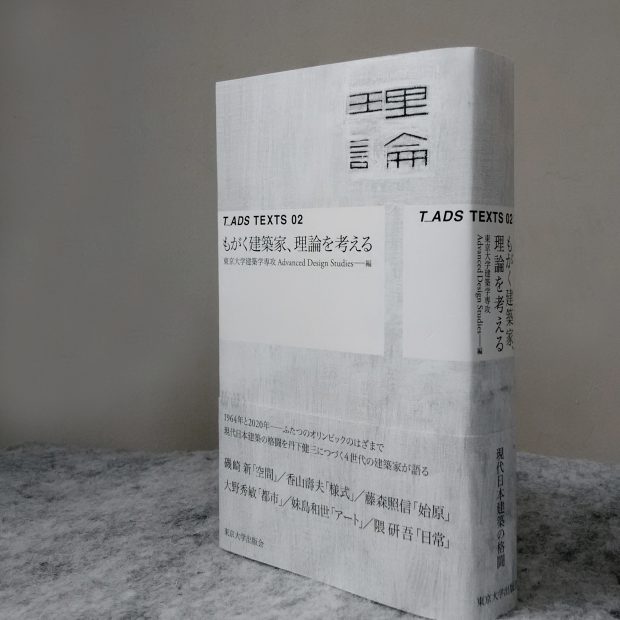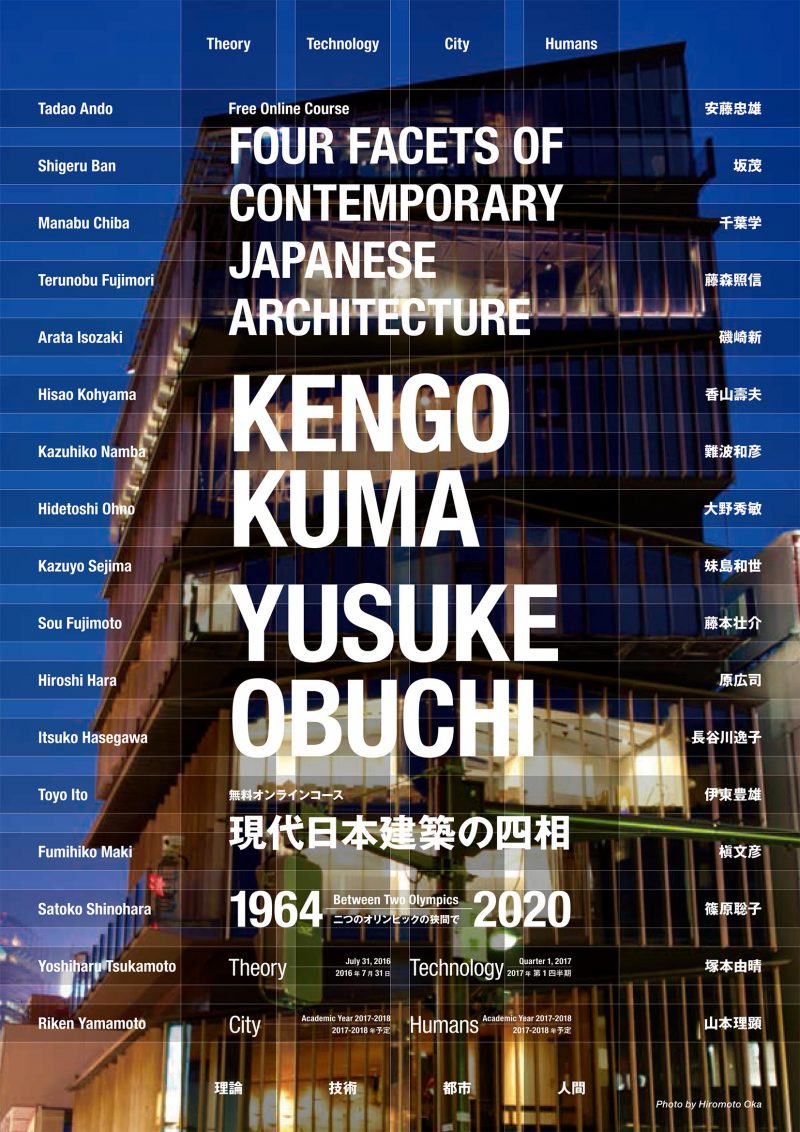Four Facets of Contemporary Japanese Architecture XSeries Program has started at edX.
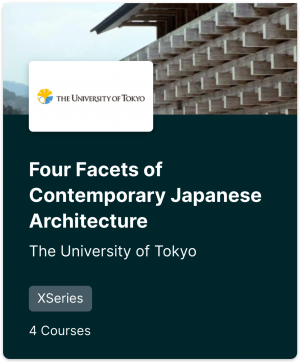
In this XSeries, you can take all four courses in the “Four Facets of Contemporary Japanese Architecture” series: “1st Facet: Theory,” “2nd Facet: Technology,” “3rd Facet: City,” and “4th Facet: Humans”. In the paid course [Verified Track], you will receive a certificate of completion by answering comprehension quizzes, but you can also view all lecture videos in the free course [Audit Track].
In this series, we have looked back on the turbulent half-century since Japan’s reconstruction after World War II, focusing on the four facets of architecture, together with the architects involved. We hope that many people will find it useful as a resource for considering the future of architecture and humanity.
Contents
FOUR FACETS OF CONTEMPORARY JAPANESE ARCHITECTURE: Theory1-1. Revisiting Kenzo Tange, Yoyogi 1st Gymnasium (1964)1-2. In Search of a Space – Arata Isozaki, The Museum of Modern Art, Gunma (1974)1-3. Learning from Style – Hisao Kohyama, Sainokuni Saitama Arts Theater (1994)1-4. New Primitivism – Terunobu Fujimori, La Collina Omihachiman (2014)1-5. Connecting the Dots – Hidetoshi Ohno, Heart Nursery School (2014)1-6. Architect without Architecture – Kengo Kuma, Asakusa Culture Tourist Information Center (2012)1-7. Too Large As Architecture Too Small As City – Kazuyo Sejima, Inujima “Art House Project” (2010-)1-8. Review – 1st Facet: Theory
FOUR FACETS OF CONTEMPORARY JAPANESE ARCHITECTURE: Technology2-1. Architecture Lives Inside People – Tadao Ando, Atelier in Oyodo II (1991)2-2. Advancing Systemic Spaces – Kazuhiko Namba, BOXHOUSE 112 (2006)2-3. What Do You Want, Wood? – Shigeru Ban, La Seine Musicale (2017)2-4. Why I Went to Countryside? – Kengo Kuma, Yusuhara Wooden Bridge Museum (2010)2-5. Design by Reinterpretation – Manabu Chiba, KOGAKUIN UNIVERSITY 125TH MEMORIAL EDUCATION CENTER (2012)2-6. In Praise of Errors – Yusuke Obuchi, DFL Pavilion (2015)2-7. Review – 2nd Facet: Technology
FOUR FACETS OF CONTEMPORARY JAPANESE ARCHITECTURE: City3-1. Architectures in Unconditional Love – Fumihiko Maki, Hillside Terrace (1969-1992)3-2. Architecture for the People – Itsuko Hasegawa, Niigata City Performing Arts Center (1998)3-3. Transparency: Literal & Behavioral – Riken Yamamoto, Saitama Prefectural University (1999)3-4. Worldly Architecture – Kengo Kuma, Nagaoka City Hall Aore (2012)3-5. Towards an Architecture of Emancipation – Jun Aoki, Omiyamae Gymnasium (2014)3-6. architecture After Architecture – Atelier Bow-Wow, Koisuru-Buta Laboratory (2012)3-7. Review – 3rd Facet: City
FOUR FACETS OF CONTEMPORARY JAPANESE ARCHITECTURE: Humans4-1. Architecture is Fiction – Hiroshi Hara, Hara House (1974)4-2. Constructing From Subconscious Images – Toyo Ito, Toyo Ito Museum of Architecture, Imabari (2011)4-3. Towards an Architecture of Interiority – Osamu Ishiyama, Gen An (1975)4-4. Living Room of the City – Kengo Kuma, V&A Dundee (2018)4-5. A House for Living Together – Satoko Shinohara, SHARE yaraicho (2012)4-6. Respect the World – Sou Fujimoto, SHIROIYA HOTEL (2020)4-7. Review – Kengo Kuma & Yusuke Obuchi, Japan National Stadium (2019)
Online courses from The University of Tokyo: https://www.edx.org/school/utokyoxIntroduction Page on the T—ADS Website: https://t-ads.org/mooc
オンライン講座「現代日本建築の四相—二つのオリンピックの狭間で」Xシリーズ スタート

このXシリーズでは、オンライン講座「現代日本建築の四相」シリーズの4つの講座「第一相:理論」「第二相:技術」「第三相:都市」「第四相:人間」のすべてを受講できます。有料コースでは、理解度を試すクイズに答えることで修了証を受けられますが、無料コースでも、すべての講義映像を視聴できます。
このシリーズでは、戦後の高度成長から現在にいたる日本の激動の半世紀を、建築の四つの相に着目して、その当事者であった建築家とともに振り返ってきました。ぜひ、これからの建築と人間の進む道を考えるための資料として、多くの方に役立てていただけることを願っています。
出演建築家
第一相:理論磯崎新、香山壽夫、藤森照信、大野秀敏、隈研吾、妹島和世
第二相:技術安藤忠雄、難波和彦、坂茂、隈研吾、千葉学、小渕祐介
第三相:都市槇文彦、長谷川逸子、山本理顕、隈研吾、青木淳、アトリエ・ワン(塚本由晴・貝島桃代)
第四相:人間原広司、伊東豊雄、石山修武、隈研吾、篠原聡子、藤本壮介
edXの東京大学サイト:https://www.edx.org/school/utokyoxT—ADS内の紹介ページ:https://t-ads.org/mooc
Free Online CourseFOUR FACETS OF CONTEMPORARY JAPANESE ARCHITECTURE — BETWEEN TWO OLYMPICSFourth Facet: Humans
Course Page on edX: Four Facets of Contemporary Japanese Architecture: Humans
Economic miracle, environmental problems, bubble economy and its collapse, information technology and globalization, earthquakes, population decline, pandemic… The nearly 60 years between the two Tokyo Olympics, 1964 and 2021, was a turbulent time for humans in Japan. During this period, how has architecture changed? And what happened to humans that architecture was supposed to have supported?
This course on “Humans” will review the works of those architects who have attempted to conceptualize humans through their architecture and examine the changes over the last half century as well as the issues for the future. Hiroshi Hara, Toyo Ito, Osamu Ishiyama, Kengo Kuma, Satoko Shinohara, and Sou Fujimoto visit their buildings to discuss the ideas behind their respective works.
Course Contents1. Architecture is Fiction – Hiroshi Hara, Hara House (1974)2. Constructing From Subconscious Images – Toyo Ito, Toyo Ito Museum of Architecture, Imabari (2011)3. Towards an Architecture of Interiority – Osamu Ishiyama, Gen An (1975)4. Living Room of the City – Kengo Kuma, V&A Dundee (2018)5. A House for Living Together – Satoko Shinohara, SHARE yaraicho (2012)6. Respect the World – Sou Fujimoto, SHIROIYA HOTEL (2020)7. Review – Kengo Kuma & Yusuke Obuchi, Japan National Stadium (2019)
This course is the fourth in the series, following “First Facet: Theory,” “Second Facet: Technology,” and “Third Facet: City,” which are currently open to the public.
Free online courses from The University of Tokyo: https://www.edx.org/school/utokyox
Introduction Page on the T—ADS Website: https://t-ads.org/mooc
無料オンラインコース現代日本建築の四相 — 二つのオリンピックの狭間で第四相:人間
オンライン講座(MOOC)プラットフォーム edX より公開Four Facets of Contemporary Japanese Architecture: Humans
高度成長、環境問題、バブル景気とその崩壊、情報化とグローバリズム、震災、人口減少、パンデミック… 1964年と2021年、2回の東京オリンピックの間の日本の約60年間は、人間をとりまく状況が大きく変化した激動の時代でした。この期間に、建築はどう変わったのでしょうか? また、建築が支えていたはずの人間はどうなったのでしょうか? 「人間」をテーマにした今回の講座では、この激動の期間を振り返りながら、建築と人間の現在と未来について考えます。
出演建築家:原広司、伊東豊雄、石山修武、隈研吾、篠原聡子、藤本壮介
このコースは、公開中の「第一相:理論」、「第二相:技術」、「第三相:都市」につづく第四弾です。
edXの東京大学サイト:https://www.edx.org/school/utokyox
T—ADS内の紹介ページ:https://t-ads.org/mooc
Intro Videos
Free Online CourseFOUR FACETS OF CONTEMPORARY JAPANESE ARCHITECTURE — BETWEEN TWO OLYMPICSThird Facet: City
Course page on edX: Four Facets of Contemporary Japanese Architecture: City
After the 1970s, Japanese architects are said to have stopped conceptualizing cities and instead focused on designing the individual buildings that make up the cities. However, as cities continue to undergo significant transformations in response to globalization, the advent of information technologies, and so on, Japanese architects are once again engaging the city, and doing so in unique ways.
This course on “City” will review the works of those architects who have attempted to conceptualize cities through their architecture and examine the changes over the last half century as well as the issues for the future. Fumihiko Maki, Itsuko Hasegawa, Riken Yamamoto, Kengo Kuma, Jun Aoki, and Atelier Bow-Wow (Yoshiharu Tsukamoto & Momoyo Kaijima) visit their buildings to discuss the ideas behind their respective works.
Course Contents1. Architectures in Unconditional Love – Fumihiko Maki, Hillside Terrace (1969-1992)2. Architecture for the People – Itsuko Hasegawa, Niigata City Performing Arts Center (1998)3. Transparency: Literal & Behavioral – Riken Yamamoto, Saitama Prefectural University (1999)4. Worldly Architecture – Kengo Kuma, Nagaoka City Hall Aore (2012)5. Towards an Architecture of Emancipation – Jun Aoki, Omiyamae Gymnasium (2014)6. architecture After Architecture – Atelier Bow-Wow, Koisuru-Buta Laboratory (2012)7. Review – 3rd Facet: City
This course is the fourth in the series, following “First Facet: Theory,” and “Second Facet: Technology,” which are currently open to the public.
Free online courses from The University of Tokyo: https://www.edx.org/school/utokyox
Introduction Page on the T—ADS Website: https://t-ads.org/mooc
無料オンラインコース 現代日本建築の四相 — 二つのオリンピックの狭間で 第三相:都市
オンライン講座(MOOC)プラットフォーム edX より公開中Four Facets of Contemporary Japanese Architecture: City
広島ピースセンター(1955)、東京計画1960、東京オリンピック(1964)、大阪万博(1970)など、1950年代から60年代において、建築家丹下健三は、数多くの都市的プロジェクトに携わりました。しかし、1970年代以降の日本では、大規模プロジェクトの減少とともに、建築家たちは都市の構想から撤退し、個々の建物の設計に専念するようになったとも言われます。しかし現在、グローバリズムや情報技術の進歩などによって都市の概念すら変わりつつあるなか、建築家たちは再び都市と向き合い、独自の方法で活動を繰り広げています。第三相「都市」では、建築から都市を考えることを継続してきた現代建築家の活動を振り返りながら、この半世紀の間に何が変わったのか、これからの課題とともに考えます。
出演建築家:槇文彦、長谷川逸子、山本理顕、隈研吾、青木淳、アトリエ・ワン
このコースは、公開中の「第一相:理論」、「第二相:技術」につづく第三弾です。
edXの東京大学サイト:https://www.edx.org/school/utokyox
T—ADS内の紹介ページ:https://t-ads.org/mooc
Intro Videos
無料オンラインコース「現代日本建築の四相 第一相:理論」が、2018年 日本建築学会教育賞(教育貢献)を受賞しました。
日本建築学会URL : https://www.aij.or.jp/2018/2018prize.html
Free Online Course “FOUR FACETS OF CONTEMPORARY JAPANESE ARCHITECTURE : Theory “ won the Prize of AIJ (Architectural Institute of Japan) for Education Award for Outstanding Practice.
Architectural Institute of Japan URL : https://www.aij.or.jp/eng/prizes/prize/prize18.html
Free Online CourseFOUR FACETS OF CONTEMPORARY JAPANESE ARCHITECTURE — BETWEEN TWO OLYMPICSSecond Facet: Technology
Course Page on edX: Four Facets of Contemporary Japanese Architecture: Technology
This is the second course of architecture series. We will focus on works by architects who explored the use of technology—from techniques used for traditional crafts to computational processes—as a vehicle for their investigations into the conceptualization and production of architecture. Tadao Ando, Kazuhiko Namba, Shigeru Ban, Manabu Chiba, Kengo Kuma, and Yusuke Obuchi will visit their buildings to discuss the ideas behind their respective works.
Course Contents1. Architecture Lives Inside People – Tadao Ando, Atelier in Oyodo II (1991)2. Advancing Systemic Spaces – Kazuhiko Namba, BOXHOUSE 112 (2006)3. What Do You Want, Wood? – Shigeru Ban, La Seine Musicale (2017)4. Why I Went to Countryside? – Kengo Kuma, Yusuhara Wooden Bridge Museum (2010)5. Design by Reinterpretation – Manabu Chiba, KOGAKUIN UNIVERSITY 125TH MEMORIAL EDUCATION CENTER (2012)6. In Praise of Errors – Yusuke Obuchi, DFL Pavilion (2015)7. Review – 2nd Facet: Technology
This course is the second in the series following “First Facet: Theory,” and is followed by “Third Facet: City” and “Fourth Facet: Humans.”
Free online courses from The University of Tokyo: https://www.edx.org/school/utokyox
Introduction Page on the T—ADS Website: https://t-ads.org/mooc
無料オンラインコース 現代日本建築の四相 — 二つのオリンピックの狭間で 第二相:技術
オンライン講座(MOOC)プラットフォーム edX より公開中Four Facets of Contemporary Japanese Architecture: Technology
現代日本建築の発展において、技術はどのような意味を持っていたのか? それは、今後どのように変わっていくのか? 6人の建築家と彼らの代表作で行われた対話から探ります。
出演建築家:安藤忠雄、難波和彦、坂茂、隈研吾、千葉学、小渕祐介
このコースは、現在公開中の 「第一相:理論」につづくシリーズ第二弾で、「第三相:都市」、「第四相:人間」に続きます。
edXの東京大学サイト:https://www.edx.org/school/utokyox
T—ADS内の紹介ページ:https://t-ads.org/mooc
Intro Videos
建築の理論について考える書籍シリーズ T_ADS TEXTS の第2号、『T_ADS TEXTS 02 もがく建築家、理論を考える』が、6月30日に東京大学出版会より出版されます。
今号は、隈研吾と小渕祐介が講師をつとめる国際オンライン講義「現代日本建築の四相 第一相:理論」Four Facets of Contemporary Japanese Architecture: Theory をまとめたもので、現代日本建築を「理論」から理解する格好の入門書になっています。
図版をふんだんに使い、オンライン講座を見た方も見ていない方も楽しめる内容になっています。ぜひお手にとってご覧ください!
Free Online Course
FOUR FACETS OF CONTEMPORARY JAPANESE ARCHITECTURE — BETWEEN TWO OLYMPICS
First Facet: Theory
無料オンラインコース
現代日本建築の四相 — 二つのオリンピックの狭間で
第一相:理論
T_ADSの隈研吾教授と小渕祐介准教授が講師をつとめる無料オンラインコース「現代日本建築の四相 — 二つのオリンピックの狭間で」の第一相「理論」が、 2016年7月31日より順次公開されます。
Four Facets of Contemporary Japanese Architecture: Theory
本コースでは、「理論」「技術」「都市」「人間」の四相から戦後の日本建築の多様性を見直すことによって、現代につながる持続的な問題意識として建築を考えます。多様性を生み出した日本を代表する建築家自身による作品解説とインタビューを通じて、現代日本建築を再解釈するとともに、これからの建築が向かうべき方向性を探ります。
第一相「理論」配信予定と出演建築家
7月31日 イントロダクション(代々木国立競技場)
8月07日 磯崎新 香山壽夫
8月14日 藤森照信 大野秀敏
8月21日 隈研吾 妹島和世
8月28日 まとめ
本コースは、2012年にハーバード大学とMITにより設立されたMOOC(Massive Open Online Course)プロバイダーであるedX(エデックス)から提供され、無料登録により世界中の誰でも視聴することができます(希望により有料の修了証も取得できます)。なお本コースは、日本語音声+英語字幕で配信されます。
Course Page on edX: Four Facets of Contemporary Japanese Architecture: Theory
Course instructors Kengo Kuma and Yusuke Obuchi have invited other leading Japanese architects to participate. Materials are delivered in Japanese with English subtitles.
Framed between the two Tokyo Olympics of 1964 and 2020, this series will explore and reflect on the diversity of contemporary Japanese architecture by focusing on four facets: theory, technology, city, and humans. Through lectures by instructors and discussions with some of the most influential Japanese architects, the course will trace the development of contemporary Japanese architecture and will consider its future direction.
Course Contents
This course is the first in a series that will continue with “Second Facet: Technology,” “Third Facet: City,” and “Fourth Facet: Humans.”
Free online courses from The University of Tokyo: https://www.edx.org/school/utokyox
Introduction Page on the T—ADS Website: https://t-ads.org/mooc
東京大学プレスリリース:
Press release from the University of Tokyo:
http://www.u-tokyo.ac.jp/ja/news/notices/notices_z0801_00002.html

